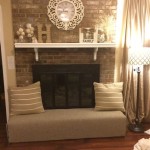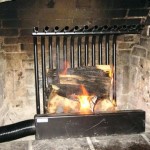Vent-Free Gas Fireplace Logs: A Comprehensive Guide
Vent-free gas fireplace logs offer a convenient and relatively simple way to introduce the ambiance and warmth of a fireplace into a home without the complexities of traditional venting systems. These log sets, also known as ventless log sets, burn cleanly enough to be operated without a chimney or flue, making them an attractive option for homeowners seeking a space-saving, energy-efficient heating solution. However, understanding the intricacies of vent-free technology, proper installation, safety considerations, and maintenance is crucial before making a purchase and operating these appliances.
The fundamental principle behind vent-free gas fireplace logs revolves around complete combustion. These systems are designed to burn fuel, typically natural gas or propane, with near-perfect efficiency. Ideally, the combustion process within a vent-free system should produce primarily carbon dioxide and water vapor, minimizing the production of harmful byproducts like carbon monoxide and unburned hydrocarbons. The absence of a venting system necessitates this high efficiency, as all combustion products are released directly into the living space.
This article aims to provide a comprehensive overview of vent-free gas fireplace logs, covering their operation, advantages, disadvantages, safety measures, installation guidelines, and crucial maintenance procedures. It is designed to equip homeowners with the knowledge necessary to make informed decisions regarding vent-free systems and ensure their safe and efficient operation.
Understanding the Operation of Vent-Free Gas Fireplace Logs
Vent-free gas fireplace logs rely on a highly engineered burner system and meticulously crafted ceramic or refractory logs to simulate the appearance of a real wood-burning fire. The burner system is the heart of the unit, responsible for mixing gas and air in precise proportions to achieve complete combustion. This process is controlled by a gas valve, which regulates the flow of fuel to the burner. Most vent-free log sets include an Oxygen Depletion Sensor (ODS) pilot, which is a critical safety component. This sensor constantly monitors the oxygen level in the room and automatically shuts off the gas supply if the oxygen concentration drops below a pre-determined threshold, indicating a potential buildup of carbon monoxide.
The logs themselves are not directly involved in the combustion process. Instead, they are strategically placed around the burner to radiate heat and create a realistic flame appearance. The materials used to construct the logs—typically ceramic or refractory cement—are designed to withstand high temperatures and retain heat effectively. The precise arrangement and design of the logs also influence the flame pattern and overall aesthetic appeal of the fireplace.
Ignition systems vary among different models of vent-free gas fireplace logs. Some units employ a standing pilot light, which continuously burns a small flame to ignite the main burner when needed. Other models use electronic ignition systems, which eliminate the need for a standing pilot and offer improved energy efficiency. These systems typically use a spark igniter to ignite the gas when the fireplace is turned on.
Modern vent-free gas fireplace logs often incorporate features like thermostatic controls, remote controls, and variable flame height adjustments, enhancing user convenience and control over the heating output and aesthetic appearance of the fire.
Advantages and Disadvantages of Vent-Free Systems
Vent-free gas fireplace logs offer several compelling advantages. One of the most significant benefits is their ease of installation. Since they do not require a chimney or flue, these systems can be installed in virtually any room with a gas connection, significantly reducing installation costs and complexity. This flexibility makes them particularly attractive for homeowners who want to add a fireplace to a room without existing venting infrastructure.
Another key advantage is their energy efficiency. Because all the heat generated by the fireplace is released directly into the room, vent-free systems boast exceptionally high efficiency ratings, often exceeding 99%. This can translate to substantial savings on heating bills compared to traditional vented fireplaces, where a significant portion of the heat escapes through the chimney.
Vent-free gas fireplace logs also offer a convenient and mess-free alternative to wood-burning fireplaces. There is no need to purchase, store, and haul firewood, and there is no ash or soot to clean up. This makes them a low-maintenance option for homeowners seeking the ambiance of a fireplace without the associated chores.
Despite these advantages, vent-free systems also have certain limitations. The primary concern is related to indoor air quality. Although designed for complete combustion, vent-free fireplaces still produce small amounts of carbon dioxide and water vapor. In poorly ventilated spaces, these byproducts can lead to increased humidity and potentially elevated levels of carbon dioxide, which can be a concern for individuals with respiratory problems or sensitivities.
Furthermore, some individuals find the odor emitted by vent-free fireplaces during operation to be unpleasant. This odor is typically caused by the combustion of dust or other particles that accumulate on the logs and burner. Regular cleaning and maintenance can help minimize this issue.
Finally, some jurisdictions have restrictions or outright bans on the use of vent-free gas appliances. It is crucial to check local building codes and regulations before installing a vent-free gas fireplace to ensure compliance.
Safety, Installation and Maintenance Considerations
Safety is paramount when operating vent-free gas fireplace logs. Proper installation and maintenance are essential to minimize the risk of carbon monoxide poisoning and ensure the safe operation of the system. It is strongly recommended that a qualified and licensed professional handle the installation of vent-free gas fireplace logs to ensure compliance with all applicable safety codes and regulations. The installer should verify proper gas line connections, ensure adequate ventilation, and thoroughly test the operation of the ODS pilot.
The ODS pilot is a critical safety feature and should be regularly inspected to ensure it is functioning correctly. Homeowners should familiarize themselves with the symptoms of carbon monoxide poisoning, which include headache, dizziness, nausea, and shortness of breath. A carbon monoxide detector should be installed in the room where the vent-free fireplace is located, and its batteries should be replaced regularly.
Adequate ventilation is crucial when operating a vent-free gas fireplace. While these systems are designed to burn cleanly, they still consume oxygen and release combustion products into the room. Opening a window slightly can help to provide fresh air and prevent the buildup of carbon dioxide. It is essential to avoid using vent-free fireplaces in tightly sealed spaces or in rooms where the air supply is restricted.
Regular maintenance is necessary to ensure the efficient and safe operation of vent-free gas fireplace logs. The logs should be cleaned periodically to remove dust and debris that can interfere with combustion. The burner should also be inspected and cleaned to ensure proper gas flow. Carbon buildup on the burner can impede combustion and increase the production of harmful emissions.
Furthermore, the gas valve and other components of the system should be inspected annually by a qualified technician to identify any potential problems. It is also important to follow the manufacturer's instructions for maintenance and troubleshooting.
Selecting the appropriate size vent-free gas fireplace log set for the room is critical for safety and comfort. Over-sized units can produce excessive heat and contribute to indoor air quality problems. The manufacturer's recommendations for room size should be carefully considered when choosing a vent-free fireplace.
Following the manufacturer's instructions regarding log placement is another important safety precaution. Incorrect log placement can obstruct the burner and disrupt the combustion process, leading to increased emissions and potentially hazardous conditions.
By adhering to these safety, installation, and maintenance guidelines, homeowners can enjoy the warmth and ambiance of vent-free gas fireplace logs while minimizing the risks associated with their operation.

Pleasant Hearth 18 Dual Fuel Wildwood Vent Free Gas Log Set 30 000 Bt

Napoleon Gvfl30 Ventless Gas Log Set 30 Inch

Vent Free Unvented Gas Logs Greenville Sc Blue Sky Chimney

Top 6 Ventless Gas Log Sets Woodlanddirect Com

Kingsman Glvf24 Log18 18 Inch Vent Free Split Oak Gas Log Set

24 Valley Oak Vent Free Log G8 Ansi Bedroom Approved Burner Peterson Real Fyre

Duluth Forge Split Red Oak 24 In Vent Free Gas Fireplace Logs With Thermostat 210069 The Home Depot

Empire Driftwood 24 Inch Electronic Ignition Vent Free Logs Fine S Gas

Empire Comfort Systems Vent Free Gas Logs Tidewater Log Doc

Outdoor Vent Free 42 Complete Gas Fireplace Stainless Steel With Remote Control Vre3200 Vre3242
Related Posts








